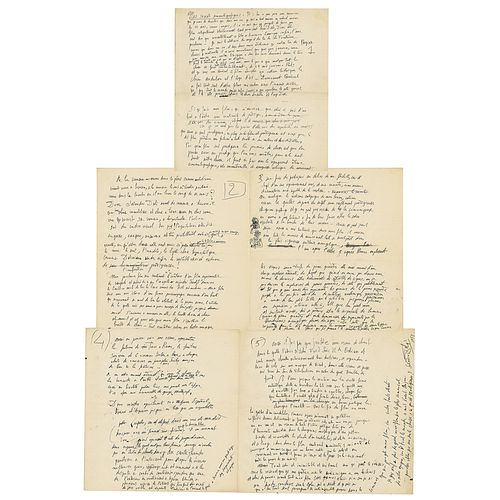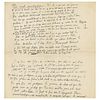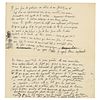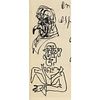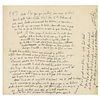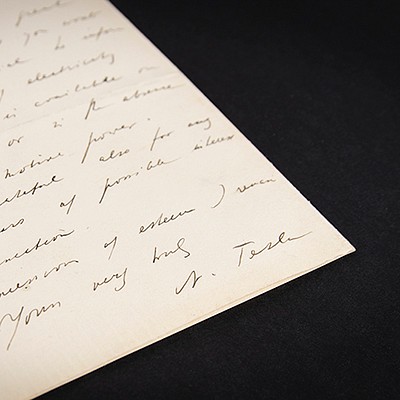Salvador Dali Autograph Manuscript Signed
Two ways to bid:
- Leave a max absentee bid and the platform will bid on your behalf up to your maximum bid during the live auction.
- Bid live during the auction and your bids will be submitted real-time to the auctioneer.
Bid Increments
| Price | Bid Increment |
|---|---|
| $0 | $5 |
| $50 | $10 |
| $200 | $25 |
| $500 | $50 |
About Auction
Jul 13, 2022
RR Auction support@rrauction.com
- Lot Description
AMS in French, signed "Salvador Dali," five pages on large 16 x 17 sheets, circa 1953. Dali's handwritten manuscript for a piece entitled 'Mes secrets sinematographiques [My cinematic secrets],' originally published in February 1954 under in No. 14 of the review La Parisienne, in an adaptation by Michel Déon, who normalized Dali's aberrant spelling and syntax. The manuscript reveals the delirious orality of the original Dalian text, with important variations; it is written in singular language, interspersed with Hispanicisms and phonetically reproducing the Catalan accent.
Dali first affirms the conviction of his genius in cinematographic art by recalling the importance of his first two films, Un chien andalou and L'Âge d'or, and by denigrating the role of the filmmaker Luis Buñuel in the realization of these. He unveils his film project La Brouette de flesh, describing the delirious visions and hallucinations he intends to put into images. On the third page, Dali sketches two interesting figures in different styles—one a grotesque portrait a la Francis Bacon, and the other executed in the Cubist mode.
In part (translated): "It's been about a week since I've discovered that in my life I'm about 12 years behind in everything, including cinema, it's 11 years since I planned to make a film that is totally totally one hundred percent hyper Dali, so that means that this film will probably end up being shot next year…I am the opposite of the orchard and the lu de La Fontaine as in my life, and already in my adolescence I did so many sensational things…At 27 I arrived in Paris and I created with Buñuel 2 films that will remain historic—Un Chien Andalou and L'Âge d'Or. Lately Buñuel has made other films on his own, so that everyone can finally know to whom belonged the brilliant side and the primary side in Le Chien andalou and L'Âge d'or….For a film to be prodigious, the first thing is for people to be able to believe in the prodigy that is shown to you, for that, above all else, is necessary to put an end to the repugnant cinematographic rhythm, this conventional and anuyuesse [boring] retort of the movement of the camera—even in the most melodrama cumun how to believe in asasin, if the camera follows him everywhere even in the sink where he will wash the blood from his hands?…My next film will be the exact opposite of an experimental vanguard film and above all of what we call today “creative” if not the servile imitation of all the commonplaces of sad modern art. My film will be a true story of a paranoid woman in love with a brute who successively takes on all the attributes of the loved one, the corpse of which had served as a means of transport; until it is embodied again in her, the bruètte becomes flesh and that is why my film will be called La Bruètte de flesh. Any refined viewer or Moayan oyster will be forced to participate in my fetishist's delirium, for this is a strictly true case, and it will be told, as no documentary is capable of realizing it…Thus I can already assure my readers that in my film he will see with all the meticulousness of the slow movements developing in the most rigorous archangelic euritmia, one after the other 5 white swans exploding. The signs will be riddled with pomegranates, also equipped with an adequate explosive charge, so that when we have been able to carefully observe the last tearings of the entrails of the swans, the explosions of the pomegranates will occur, probably such that we have already experienced the grains of the pomegranate progetated at the periphery of the anatomical dismemberment, reaching because of their small size through the intertices to the feathers in suspension, orteron these, such as one can dream and above all daydream, must occur between the corpuscles of light (pomegranate seeds and light waves represented by the archangelic feathers of the sign). So that the corpuscles in the said experience will have the corporality of Mantaigne and the feathers the flue which made the painter Eugène Carrière famous. Also we will be able to see a scene, representing the Trevi fountain in Rome, the windows open and 6 rhinoceros fall into the water, with each fall of rhinoceros a black umbrella emerges from the water of the fountain….In another opportunity, 100 Spanish ziganes will kill and dismember until only their bare skeleton is left, an elephant in a street in Madrid (thus transposing a famous African scene that I read in a book). At a given moment when the ribs of the paquiderm appear, two ziganes (who, despite their savage frenzy, do not stop an instinct from singing canté hondo, penetrate inside to grab the better viscera, quer, rognongs, etc." In fine condition, with intersecting folds. A remarkable and impressive artistic manuscript that is distinctly Dali. - Shipping Info
-
Bidder is liable for shipping and handling and providing accurate information as to shipping or delivery locations and arranging for such. RR Auction is unable to combine purchases from other auctions or affiliates into one package for shipping purposes. Lots won will be shipped in a commercially reasonable time after payment in good funds for the merchandise and the shipping fees are received or credit extended, except when third-party shipment occurs. Bidder agrees that service and handling charges related to shipping items which are not pre-paid may be charged to a credit card on file with RR Auction. Successful international Bidders shall provide written shipping instructions, including specified Customs declarations, to RR Auction for any lots to be delivered outside of the United States. NOTE: Declaration value shall be the item’(s) hammer price and RR Auction shall use the correct harmonized code for the lot. Domestic Bidders on lots designated for third-party shipment must designate the common carrier, accept risk of loss, and prepay shipping costs.
-
- Buyer's Premium



 EUR
EUR CAD
CAD AUD
AUD GBP
GBP MXN
MXN HKD
HKD CNY
CNY MYR
MYR SEK
SEK SGD
SGD CHF
CHF THB
THB